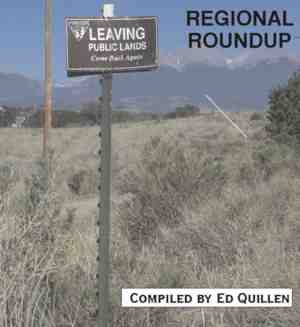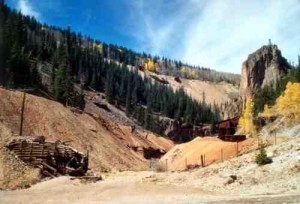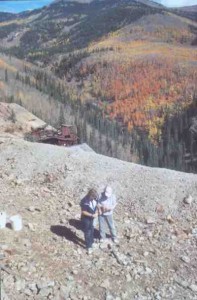Brief by Ed Quillen
Local News – July 2006 – Colorado Central Magazine
The Return of Elephant Rock?
Back in the 1980s and early 1990s, the Colorado Springs water department proposed building a dam across the Arkansas River north of Buena Vista, and the resulting impoundment would be Elephant Rock Reservoir, named for a monolith near the river popular with rock climbers.
It was fervently opposed by most local residents, but Colorado Springs said it needed more water storage. Eventually, the Springs started pushing for expansion of Pueblo Reservoir, already in place downstream from Cañon City. And so Elephant Rock Reservoir appeared to go away.
However, there was a legal notice from the state water court in the May 18 edition of the Chaffee County Times of Buena Vista. It was a City of Colorado Springs “Application for Conditional Appropriative Rights of Substitution and Exchange” in various counties, and on the list was “Elephant Rock Reservoir Project,” with a dam “approximately 1100 feet long” that sits “on the Arkansas River.”
The deadline for filing objections is June 30. Lounell Thayer-Rush of Buena Vista brought this to our attention, and if you want to join in the objections, call her at 719-395-8542.

How dry we are
For most of the winter, the snowpack looked pretty good in the north part of the state, while the south part suffered. But a dry spell in April and May, along with warm snow-eating weather, has pretty much eliminated all optimism about moisture this summer.
And now the wildfires come. At press time, the 700-acre Tyndall Gulch fire in Custer County was contained, so Colo. 96 could be re-opened. At its peak, the fire threatened about 40 homes, forcing some evacuations. It was apparently started when 45-mph winds knocked a tree into a power line, which collapsed and ignited dry vegetation.
The firefighters got some help from rainy weather on June 16, but the rain was accompanied by lightning, which started five small fires in Custer County. All were soon extinguished, though.
Over Memorial Day weekend, a fire consumed 101 acres in the Pine Valley area near Bailey in Park County. It started May 28 and threatened to spread due to aridity and wind, but cool weather arrived to help the firefighters. Several residents had to evacuate briefly.
Our counties have been imposing bans on outdoor fires, and the U.S. Forest Service sends rangers around to campgrounds. But it doesn’t seem to be getting across. Over Memorial Day weekend, rangers in Pike-San Isabel National Forest found 17 campfires that were abandoned but still smoking.
An Ill Wind
We’re used to seeing stories about high winds from South Park, the Wet Mountain Valley, the San Luis Valley, the Upper Arkansas Valley. And now there’s one from the Gunnison Country.
On the night of June 6, strong wind gusts knocked over trees, which in turn took down power poles and lines. Parts of the city lost power for about two hours. Outside of town, the wind caused power to be off in Almont and Ohio City for up to three hours.
“It could be worse,” observed Gunnison resident Mitch Pecaric, since it could have happened during the subzero cold of January.
Meanwhile, fire-weakened trees that remained from the 2002 fires in Park County were blowing down, and there didn’t seem to be any way to spot weak trees in advance. A tree-trimming service employee was severely injured by a falling tree while inspecting suspected hazardous trees for a private landowner — and this tree wasn’t one anybody was concerned about.
That prompted a piece of official advice: “If the wind is blowing, don’t go out.” But this year, that could mean staying indoors most of the time.
Body Discoveries
Just about every episode of the popular television series “Law and Order” starts with the accidental discovery of a corpse somewhere in New York City. But this is not strictly a Manhattan phenomenon.
On the morning of May 17, the body of 35-year-old Brent Jackson was found in a dumpster behind the Quincy Building in Leadville. It appeared to be a suicide, since police found a pistol in his hand, a bullet hole in his chin, and a matching cartridge case near the body. Jackson had lost his job and his vehicle in the recent past, according to police reports.
In Park County, the body came to the sheriff’s department. On June 2, 31-year-old Robert Pastore drove a van into the parking lot of the department’s Bailey substation and turned himself in.
In the back of his van was the body of Denver resident Raymond Twiggs, who had been strangled five days earlier. Pastore told police it happened in Aurora because Twiggs had threatened his wife and children, and he had been driving around the mountains since then before turning himself in.
Gas Prices & Tourism
According to a study conducted by the AAA (formerly initials standing for “American Automobile Association,” gasoline prices will have to reach $3.50 a gallon before they affect most people’s vacation plans this summer.
That was welcome news to a May gathering of the Gunnison-Crested Butte Tourism Association. Its computer models predict an 11% increase in bookings in July compared to 2005, which in turn was 16% ahead of 2004.
Even so, the Tourism Authority is aware that “everybody has a sensitivity to gas prices,” and will consequently market more to in-state tourists this year.
Sales Tax Mess
Gunnison County has been collecting more sales tax than it was supposed to, and over the years, that could amount to millions of dollars.
When the county sales tax was enacted in 1978, groceries were supposed to be exempt. But when local resident T.L. Livermore tried to figure out sales taxes while volunteering with the farmers’ market, his calculations for the market didn’t match the reckoning on his own grocery receipts. So he started asking questions.
In 2005 alone, the county collected about $225,000 in sales tax from groceries. The county commissioners will have to take some action, since “It’s not pocket change,” according to commissioner Hap Channell.
New Bear Fare?
When the weather warms, the bears come out. They’re hungry, so there are many accounts of them raiding homes, sheds, bird feeders, picnic coolers, trash containers, and the like.
And on the first weekend of June, two goats were killed near Gunnison. “We’re not 100% sure it was a bear, but it sure looks likely,” according to J. Wenum of the Colorado Division of Wildlife. It’s probably the same bear that was rambling through the nearby Dos Rios subdivision and KOA campground.
Observations
“If I could agree that we have too many liquor stores because of whatever reason that they give, then I would have to agree with others that we have too many homes and cabins being built in Park County, and that being the case, then we have too many carpenters, electricians, plumbers, etc. in Park County also.”
— Timm Armstrong in the Fairplay Flume, June 2.
“The simple good driving habit of signaling when making a turn, and bad habit of neglecting to signal, are telltale of how successful we are in life.”
— Mike Bullock in the Chaffee County Times, May 25.
We should note that it was always our understanding that people don’t use turn signals in small towns because everybody already knows where you’re going.
“The voters voted for me with this beard, and it’s who I am, and I’m not going to shave it off.”
— The late Park County Commissioner Jim Gardner, who died of cancer May 19. He sported a chest-length beard.
“Authorities learned a man lit five fires around his campsite. Firefighters made sure the fires were out and Salida police officers advised the camper not to light any more.”
— Paul Goetz in the Salida Mountain Mail, May 30.
“The reality is we have bankrupted our water account. Many people are in denial of the seriousness of the water situation, and the condition of the aquifer. We are faced with shutting off wells — like it or not. Ongoing consumptive use, combined with drought, has compromised the recharge of the aquifer.”
— Steve Vandiver of the Rio Grande Water Conservation District, quoted in the Crestone Eagle, June 1.
“Year four after a fire is when we start seeing a lot of trees go down. The tops of the trees become a big sale with a bunch of rot at the bottom. When the wind blows the sails fill and the masts snap.”
— Randy Hickenbottom of the U.S. Forest Service, quoted in the Fairplay Flume, June 2.



